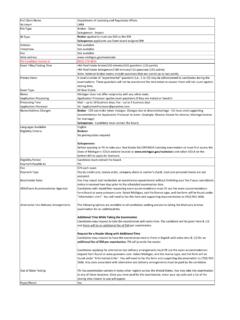Transcription of Real-time payments are changing the reality of payments
1 Real-time payments are changing the reality of payments Contents #paynow 1. Why cash may be a thing of the past 2. How do Real-time payments work? 3. Potential benefits of Real-time payments 4. Real-time payments go global 5. What is driving the growth of Real-time payments ? 6. What action can be taken now? 8. Developing a roadmap 10. #startnow 11. 2. #paynow The mass adoption of Real-time payment systems around the globe has contributed to an environment in which many consumers, merchants, and financial institutions expect to be able to pay friends and customers, settle bills, and transfer money at the drop of a hat.
2 While the concept of paying now is not a new one cash is an immediate payment transaction instrument after all the growth of Real-time payment options has helped build a new standard among consumers. This new standard is driving change for traditional payment types . checks, credit, debit, prepaid, and the like as consumers have generally come to expect faster settlement periods, notifications and consolidated reporting. The question for financial institutions is whether they're ready for #paynow? Real-time payments are changing the reality of payments 1.
3 Why cash may be a thing of the past Ever since money was invented in the 7th century BC, European Central Bank, the total cost of cash in the the exchange of paper, metal, and other forms of hard European Union is 1% or more of Similarly, the cost currency has generally been the most convenient way to to support cash in the US is $200 billion pay in Real-time for every day purchases. Even with the introduction of checks and credit cards, cash is still used The growing ubiquity of smart devices and booming to conveniently exchange funds in an immediate fashion.
4 Online retail commerce in markets outside of the US. is driving the rapid adoption of Real-time payments . However, the ease of use of cash has also faced several Increasingly, demanding consumers may be turning to challenges. For instance, cash is an expansive instrument, their smartphones when they need to pay merchants, requiring printing storage, circulation logistics and costs, billers, peers and others. While the private sector making it difficult to store and transport. Moreover, many has typically driven adoption to promote commerce, transactions no longer occur in person, which require governments tend to lag behind; yet increased usage other methods of payment.
5 Cash can also incur costs, of real time payments could help them increase tax such as check-cashing and ATM fees. According to the collection and enhance fraud prevention. Faster payment schemes There are many faster payment schemes available around the globe aimed at expediting the availability of funds by creating a workaround for underlying Clearing & Settlement mechanisms. Yet a single approach for the industry has not yet evolved. One such example of faster payment is the Interbanking Electronic Payment System, SPEI, of the Banco de Mexico which clears low value transactions every 20 seconds during working hours.
6 Other countries have chosen to implement multiple batch systems with clearing cycles that are designed in the same manner as traditional systems, but repeated many a times a day. 1. Press Release-New ECB report examines the costs of making payments in the European Union. European Central Bank, October 1, 2012. 2. "The Cost of Cash in the United States," Bhaskar Chakravorti and Benjamin Mazzotta, The Fletcher School Tufts University, 2013. 2. How do Real-time payments work? Most existing Real-time payment systems offer an instant, The main aspects of most real time payments are: 24/7, interbank electronic fund transfer service that can be initiated through one of many channels: smart phones, tablets, digital wallets, and the web.
7 In such a scheme, a low value Real-time payment request is initiated that enables an interbank account-to-account payment fund transfer and secure transaction posting with immediate notification features. Authorization Posting Settlement Notification Certification of Funds are made Instant settlement Payee receives the payment immediately of outstanding funds and payer available obligations between receives confirmation to of the financial institutions of the status of the transaction transaction Real-time payments are changing the reality of payments 3.
8 Potential benefits of Real-time payments Real-time payments can benefit financial institutions (FIs), merchants, consumers and society by offering enhanced visibility into payments , by enabling better cash management and by helping businesses better manage day-to-day operations by improving liquidity. The liquidity improvement can be especially impactful to small merchants who may be used to waiting days for their settlement, possibly creating a positive impact on their cash flow and daily sales outstanding (DSOs). Five categories of Real-time payments When considering the Real-time payment landscape, there are five common categories of payments .
9 Each in turn has great potential to disrupt the existing payment ecosystem in the next 2-3 years Category of Payment Descriptions Size of Transactions Key Considerations 1. Business to Business (B2B) Supplier payments Low 2. Business to Consumer (B2C) Legal Settlements Medium to High Insurance claims Contingent Employee wages Real-time authorization/clearing 3. Consumer to Business (C2B) Bill Pay Low to Medium Intra-day availability of funds Hospital Co-pay Intra-day interbank settlement Pay at POS. Late-day interbank settlement 4.
10 Domestic Peer to Peer (P2P) Repayment to Friends/Family Low to High 5. Cross Border Peer to Peer (P2P) Remittance to Family/Friends Medium to High Source: Deloitte analysis One example is the Peer to Peer (P2P) space, where there are currently more than twenty applications in the US market, enabling payments on smartphones, using bank accounts or debit cards. Forrester forecasts that P2P payments will reach up to $17 billion by the end of 2019 from $5 billion in We believe this rapid growth of P2P is largely driven by accessibility, and an attractive user experience that focuses on speed and convenience for both domestic transfers and cross-border remittances.














